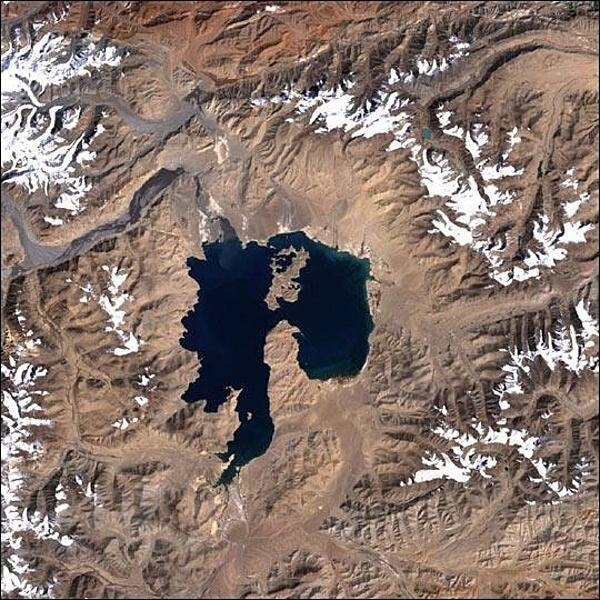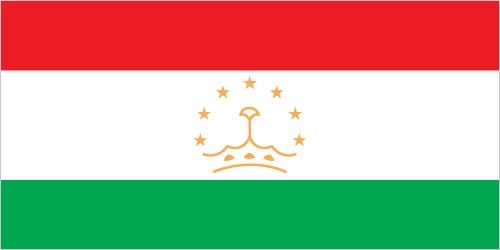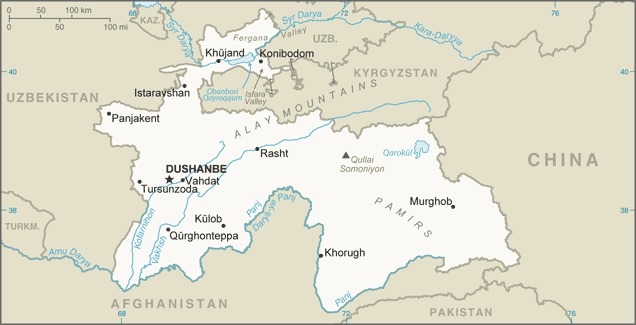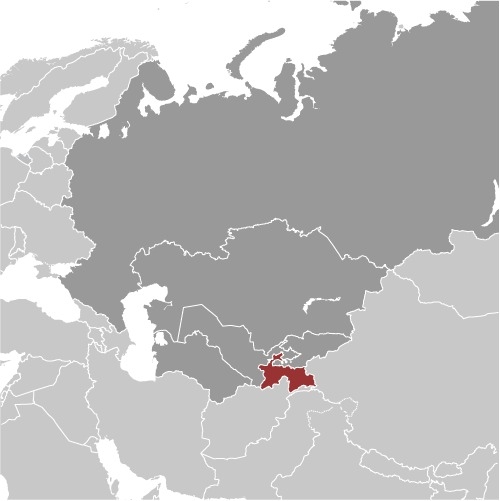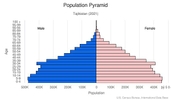Tajikistan
Introduction
Background
The Tajik people came under Russian imperial rule in the 1860s and 1870s, but Russia's hold on Central Asia weakened following the Revolution of 1917. At that time, bands of indigenous guerrillas (known as "basmachi") fiercely contested Bolshevik control of the area, which was not fully reestablished until 1925. Tajikistan was first created as an autonomous republic within Uzbekistan in 1924, but in 1929 the USSR designated Tajikistan a separate republic and transferred to it much of present-day Sughd province. Ethnic Uzbeks form a substantial minority in Tajikistan, and ethnic Tajiks an even larger minority in Uzbekistan. Tajikistan became independent in 1991 following the breakup of the Soviet Union, and experienced a civil war between political, regional, and religious factions from 1992 to 1997.
Though the country holds general elections for both the presidency (once every seven years) and legislature (once every five years), observers note an electoral system rife with irregularities and abuse, with results that are neither free nor fair. President Emomali RAHMON, who came to power in 1992 during the civil war and was first elected president in 1994, used an attack planned by a disaffected deputy defense minister in 2015 to ban the last major opposition political party in Tajikistan. In December 2015, RAHMON further strengthened his position by having himself declared "Founder of Peace and National Unity, Leader of the Nation," with limitless terms and lifelong immunity through constitutional amendments ratified in a referendum. The referendum also lowered the minimum age required to run for president from 35 to 30, which made RAHMON's first-born son Rustam EMOMALI, the mayor of the capital city of Dushanbe, eligible to run for president in 2020. In April 2020, RAHMON orchestrated EMOMALI's selection as Chairman of the Majlisi Milli (Tajikistan's senate), positioning EMOMALI as next in line of succession for the presidency. RAHMON opted to run in the presidential election in October 2020 and received 91% of the vote.
The country remains the poorest in the former Soviet sphere. Tajikistan became a member of the WTO in March 2013. However, its economy continues to face major challenges, including dependence on remittances from Tajikistani migrant laborers working in Russia and Kazakhstan, pervasive corruption, and the opiate trade and other destabilizing violence emanating from neighboring Afghanistan. Tajikistan has endured several domestic security incidents since 2010, including armed conflict between government forces and local strongmen in the Rasht Valley and between government forces and criminal groups in Gorno-Badakhshan Autonomous Oblast. Tajikistan suffered its first ISIS-claimed attack in 2018, when assailants attacked a group of Western bicyclists with vehicles and knives, killing four.
Visit the Definitions and Notes page to view a description of each topic.
Geography
Location
Central Asia, west of China, south of Kyrgyzstan
Geographic coordinates
39 00 N, 71 00 E
Map references
Asia
Area - comparative
slightly smaller than Wisconsin
Land boundaries
total: 4,130 km
border countries (4): Afghanistan 1357 km, China 477 km, Kyrgyzstan 984 km, Uzbekistan 1312 km
Coastline
0 km (landlocked)
Maritime claims
none (landlocked)
Climate
mid-latitude continental, hot summers, mild winters; semiarid to polar in Pamir Mountains
Terrain
mountainous region dominated by the Trans-Alay Range in the north and the Pamirs in the southeast; western Fergana Valley in north, Kofarnihon and Vakhsh Valleys in southwest
Elevation
highest point: Qullai Ismoili Somoni 7,495 m
lowest point: Syr Darya (Sirdaryo) 300 m
mean elevation: 3,186 m
Natural resources
hydropower, some petroleum, uranium, mercury, brown coal, lead, zinc, antimony, tungsten, silver, gold
Land use
agricultural land: 34.7% (2018 est.)
arable land: 6.1% (2018 est.)
permanent crops: 0.9% (2018 est.)
permanent pasture: 27.7% (2018 est.)
forest: 2.9% (2018 est.)
other: 62.4% (2018 est.)
Irrigated land
7,420 sq km (2012)
Major rivers (by length in km)
Syr Darya (shared with Kyrgyzstan [s], Uzbekistan, and Kazakhstan [m]) - 3,078 km; Amu Darya river source (shared with Turkmenistan, Afghanistan, and Uzbekistan [m]) - 2,620 km
note – [s] after country name indicates river source; [m] after country name indicates river mouth
Major watersheds (area sq km)
Internal (endorheic basin) drainage: Tarim Basin (1,152,448 sq km), (Aral Sea Basin) Amu Darya (534,739 sq km), Syr Darya (782,617 sq km)
Population distribution
the country's population is concentrated at lower elevations, with perhaps as much as 90% of the people living in valleys; overall density increases from east to west
Natural hazards
earthquakes; floods
Geography - note
landlocked; highest point, Qullai Ismoili Somoni (formerly Communism Peak), was the tallest mountain in the former USSR
People and Society
Nationality
noun: Tajikistani(s)
adjective: Tajikistani
Ethnic groups
Tajik 84.3% (includes Pamiri and Yagnobi), Uzbek 13.8%, other 2% (includes Kyrgyz, Russian, Turkmen, Tatar, Arab) (2014 est.)
Languages
Tajik (official) 84.4%, Uzbek 11.9%, Kyrgyz 0.8%, Russian 0.5%, other 2.4% (2010 est.)
major-language sample(s):
Китоби Фактҳои Ҷаҳонӣ, манбаи бебадали маълумоти асосӣ (Tajik)
The World Factbook, the indispensable source for basic information.
note: Russian widely used in government and business
Religions
Muslim 98% (Sunni 95%, Shia 3%) other 2% (2014 est.)
Age structure
0-14 years: 31.43% (male 1,420,271/female 1,368,445)
15-24 years: 18.13% (male 816,658/female 792,231)
25-54 years: 40.58% (male 1,789,271/female 1,811,566)
55-64 years: 6.23% (male 253,862/female 299,378)
65 years and over: 3.63% (male 132,831/female 189,156) (2020 est.)
Dependency ratios
total dependency ratio: 67.9
youth dependency ratio: 62.6
elderly dependency ratio: 5.3
potential support ratio: 18.7 (2020 est.)
Median age
total: 25.3 years
male: 24.6 years
female: 26 years (2020 est.)
Population distribution
the country's population is concentrated at lower elevations, with perhaps as much as 90% of the people living in valleys; overall density increases from east to west
Urbanization
urban population: 27.7% of total population (2021)
rate of urbanization: 2.73% annual rate of change (2020-25 est.)
Major urban areas - population
938,000 DUSHANBE (capital) (2021)
Sex ratio
at birth: 1.05 male(s)/female
0-14 years: 1.04 male(s)/female
15-24 years: 1.03 male(s)/female
25-54 years: 0.99 male(s)/female
55-64 years: 0.85 male(s)/female
65 years and over: 0.7 male(s)/female
total population: 0.99 male(s)/female (2020 est.)
Mother's mean age at first birth
21.9 years (2017 est.)
note: median age at first birth among women 25-49
Maternal mortality ratio
17 deaths/100,000 live births (2017 est.)
country comparison to the world: 132Infant mortality rate
total: 33.05 deaths/1,000 live births
male: 37.8 deaths/1,000 live births
female: 28.06 deaths/1,000 live births (2021 est.)
Life expectancy at birth
total population: 69.06 years
male: 65.91 years
female: 72.38 years (2021 est.)
Contraceptive prevalence rate
29.3% (2017)
Drinking water source
improved: urban: 96.2% of population
rural: 78.6% of population
total: 83.5% of population
unimproved: urban: 3.8% of population
rural: 21.4% of population
total: 16.5% of population (2017 est.)
Current Health Expenditure
7.2% (2018)
Physicians density
2.1 physicians/1,000 population (2014)
Hospital bed density
4.7 beds/1,000 population (2014)
Sanitation facility access
improved: urban: 99.7% of population
rural: 99.3% of population
total: 99.4% of population
unimproved: urban: 0.3% of population
rural: 0.7% of population
total: 2% of population (2017 est.)
HIV/AIDS - deaths
<500 (2020 est.)
Major infectious diseases
degree of risk: high (2020)
food or waterborne diseases: bacterial diarrhea, hepatitis A, and typhoid fever
vectorborne diseases: malaria
Literacy
definition: age 15 and over can read and write
total population: 99.8%
male: 99.8%
female: 99.7% (2015)
School life expectancy (primary to tertiary education)
total: 11 years
male: 12 years
female: 11 years (2013)
Environment
Environment - current issues
areas of high air pollution from motor vehicles and industry; water pollution from agricultural runoff and disposal of untreated industrial waste and sewage; poor management of water resources; soil erosion; increasing levels of soil salinity
Environment - international agreements
party to: Biodiversity, Climate Change, Climate Change-Kyoto Protocol, Climate Change-Paris Agreement, Comprehensive Nuclear Test Ban, Desertification, Endangered Species, Environmental Modification, Hazardous Wastes, Ozone Layer Protection, Ship Pollution, Wetlands
signed, but not ratified: none of the selected agreements
Air pollutants
particulate matter emissions: 40.05 micrograms per cubic meter (2016 est.)
carbon dioxide emissions: 5.31 megatons (2016 est.)
methane emissions: 4.87 megatons (2020 est.)
Climate
mid-latitude continental, hot summers, mild winters; semiarid to polar in Pamir Mountains
Land use
agricultural land: 34.7% (2018 est.)
arable land: 6.1% (2018 est.)
permanent crops: 0.9% (2018 est.)
permanent pasture: 27.7% (2018 est.)
forest: 2.9% (2018 est.)
other: 62.4% (2018 est.)
Urbanization
urban population: 27.7% of total population (2021)
rate of urbanization: 2.73% annual rate of change (2020-25 est.)
Revenue from forest resources
forest revenues: 1.12% of GDP (2018 est.)
country comparison to the world: 51Major infectious diseases
degree of risk: high (2020)
food or waterborne diseases: bacterial diarrhea, hepatitis A, and typhoid fever
vectorborne diseases: malaria
Waste and recycling
municipal solid waste generated annually: 1,787,400 tons (2013 est.)
Major rivers (by length in km)
Syr Darya (shared with Kyrgyzstan [s], Uzbekistan, and Kazakhstan [m]) - 3,078 km; Amu Darya river source (shared with Turkmenistan, Afghanistan, and Uzbekistan [m]) - 2,620 km
note – [s] after country name indicates river source; [m] after country name indicates river mouth
Major watersheds (area sq km)
Internal (endorheic basin) drainage: Tarim Basin (1,152,448 sq km), (Aral Sea Basin) Amu Darya (534,739 sq km), Syr Darya (782,617 sq km)
Total water withdrawal
municipal: 647 million cubic meters (2017 est.)
industrial: 407.8 million cubic meters (2017 est.)
agricultural: 10.44 billion cubic meters (2017 est.)
Total renewable water resources
21.91 billion cubic meters (2017 est.)
Government
Country name
conventional long form: Republic of Tajikistan
conventional short form: Tajikistan
local long form: Jumhurii Tojikiston
local short form: Tojikiston
former: Tajik Soviet Socialist Republic
etymology: the Persian suffix "-stan" means "place of" or "country," so the word Tajikistan literally means "Land of the Tajik [people]"
Government type
presidential republic
Capital
name: Dushanbe
geographic coordinates: 38 33 N, 68 46 E
time difference: UTC+5 (10 hours ahead of Washington, DC, during Standard Time)
etymology: today's city was originally at the crossroads where a large bazaar occurred on Mondays, hence the name Dushanbe, which in Persian means Monday, i.e., the second day (du) after Saturday (shambe)
Administrative divisions
2 provinces (viloyatho, singular - viloyat), 1 autonomous province* (viloyati mukhtor), 1 capital region** (viloyati poytakht), and 1 area referred to as Districts Under Republic Administration***; Dushanbe**, Khatlon (Bokhtar), Kuhistoni Badakhshon [Gorno-Badakhshan]* (Khorugh), Nohiyahoi Tobei Jumhuri***, Sughd (Khujand)
note: the administrative center name follows in parentheses
Independence
9 September 1991 (from the Soviet Union)
National holiday
Independence Day (or National Day), 9 September (1991)
Constitution
history: several previous; latest adopted 6 November 1994
amendments: proposed by the president of the republic or by at least one third of the total membership of both houses of the Supreme Assembly; adoption of any amendment requires a referendum, which includes approval of the president or approval by at least two-thirds majority of the Assembly of Representatives; passage in a referendum requires participation of an absolute majority of eligible voters and an absolute majority of votes; constitutional articles, including Tajikistan’s form of government, its territory, and its democratic nature, cannot be amended; amended 1999, 2003, 2016
Legal system
civil law system
International law organization participation
has not submitted an ICJ jurisdiction declaration; accepts ICCt jurisdiction
Citizenship
citizenship by birth: no
citizenship by descent only: at least one parent must be a citizen of Tajikistan
dual citizenship recognized: no
residency requirement for naturalization: 5 years or 3 years of continuous residence prior to application
Suffrage
18 years of age; universal
Executive branch
chief of state: President Emomali RAHMON (since 6 November 1994; head of state and Supreme Assembly chairman since 19 November 1992)
head of government: Prime Minister Qohir RASULZODA (since 23 November 2013)
cabinet: Council of Ministers appointed by the president, approved by the Supreme Assembly
elections/appointments: president directly elected by simple majority popular vote for a 7-year term for a maximum of two terms; however, as the "Leader of the Nation" President RAHMON can run an unlimited number of times; election last held on 11 October 2020 (next to be held in 2027); prime minister appointed by the president
election results: Emomali RAHMON reelected president; percent of vote - Emomali RAHMON (PDPT) 90.9%
Legislative branch
description: bicameral Supreme Assembly or Majlisi Oli consists of:
National Assembly or Majlisi Milli (34 seats; 25 members indirectly elected by local representative assemblies or majlisi, 8 appointed by the president, and 1 reserved for each living former president; members serve 5-year terms)
Assembly of Representatives or Majlisi Namoyandagon (63 seats; 41 members directly elected in single-seat constituencies by 2-round absolute majority vote and 22 directly elected in a single nationwide constituency by closed-list proportional representation vote; members serve 5-year terms)
elections:
National Assembly - last held on 1 March 2020 (next to be held in 2025)
Assembly of Representatives - last held on 1 March 2020 (next to be held in 2025)
election results:
National Assembly - percent of vote by party - NA; seats by party - NA; composition - men 28, women 6, percent of women 17.6%
Assembly of Representatives - percent of vote by party - PDPT 50.4%, PERT 16.6%, APT 16.5%, SPT 5.2%, DPT 5.1%, CPT 3.1%, other 3.1%; seats by party - PDPT 47, APT 7, PERT 5, CPT 2, SPT 1, DPT 1; composition - men 48, women 15, percent of women 23.8%; note - total Supreme Assembly percent of women 21.6%
Judicial branch
highest courts: Supreme Court (consists of the chairman, deputy chairmen, and 34 judges organized into civil, family, criminal, administrative offense, and military chambers); Constitutional Court (consists of the court chairman, deputy chairman, and 5 judges); High Economic Court (consists of 16 judicial positions)
judge selection and term of office: Supreme Court, Constitutional Court, and High Economic Court judges nominated by the president and approved by the National Assembly; judges of all 3 courts appointed for 10-year renewable terms with no term limits, but the last appointment must occur before the age of 65
subordinate courts: regional and district courts; Dushanbe City Court; viloyat (province level) courts; Court of Gorno-Badakhshan Autonomous Region
Political parties and leaders
Agrarian Party of Tajikistan or APT [Rustam LATIFZODA]
Communist Party of Tajikistan or CPT [Miroj ABDULLOEV]
Democratic Party of Tajikistan or DPT [Saidjafar USMONZODA]
Party of Economic Reform of Tajikistan or PERT [Rustam OUDRATOV]
People's Democratic Party of Tajikistan or PDPT [Emomali RAHMON]
Social Democratic Party of Tajikistan or SDPT [Qiyomiddin AZIZOV]
Socialist Party of Tajikistan or SPT [Abduhalim GHAFFOROV]
International organization participation
ADB, CICA, CIS, CSTO, EAEC, EAPC, EBRD, ECO, EITI (candidate country), FAO, G-77, GCTU, IAEA, IBRD, ICAO, ICC (NGOs), ICCt, ICRM, IDA, IDB, IFAD, IFC, IFRCS, ILO, IMF, Interpol, IOC, IOM, IPU, ISO (correspondent), ITSO, ITU, MIGA, NAM (observer), OIC, OPCW, OSCE, PFP, SCO, UN, UNCTAD, UNESCO, UNIDO, UNWTO, UPU, WCO, WFTU (NGOs), WHO, WIPO, WMO, WTO
Diplomatic representation in the US
chief of mission: Ambassador Farrukh HAMRALIZODA (since 17 February 2021)
chancery: 1005 New Hampshire Avenue NW, Washington, DC 20037
telephone: [1] (202) 223-6090; [1] (202) 223-2666
FAX: [1] (202) 223-6091
email address and website:
tajemus@mfa.tj; tajikistan@verizon.net
https://mfa.tj/en/washington
Diplomatic representation from the US
chief of mission: Ambassador John Mark POMMERSHEIM (since 15 March 2019)
embassy: 109-A Ismoili Somoni Avenue (Zarafshon district), Dushanbe 734019
mailing address: 7090 Dushanbe Place, Washington DC 20521-7090
telephone: [992] (37) 229-20-00
FAX: [992] (37) 229-20-50
email address and website:
DushanbeConsular@state.gov
https://tj.usembassy.gov/
Flag description
three horizontal stripes of red (top), a wider stripe of white, and green; a gold crown surmounted by seven gold, five-pointed stars is located in the center of the white stripe; red represents the sun, victory, and the unity of the nation, white stands for purity, cotton, and mountain snows, while green is the color of Islam and the bounty of nature; the crown symbolizes the Tajik people; the seven stars signify the Tajik magic number "seven" - a symbol of perfection and the embodiment of happiness
National symbol(s)
crown surmounted by an arc of seven, five-pointed stars; snow leopard; national colors: red, white, green
National anthem
name: "Surudi milli" (National Anthem)
lyrics/music: Gulnazar KELDI/Sulaimon YUDAKOV
note: adopted 1991; after the fall of the Soviet Union, Tajikistan kept the music of the anthem from its time as a Soviet republic but adopted new lyrics
Economy
Economic overview
Tajikistan is a poor, mountainous country with an economy dominated by minerals extraction, metals processing, agriculture, and reliance on remittances from citizens working abroad. Mineral resources include silver, gold, uranium, antimony, tungsten, and coal. Industry consists mainly of small obsolete factories in food processing and light industry, substantial hydropower facilities, and a large aluminum plant - currently operating well below its capacity. The 1992-97 civil war severely damaged an already weak economic infrastructure and caused a sharp decline in industrial and agricultural production. Today, Tajikistan is the poorest among the former Soviet republics. Because less than 7% of the land area is arable and cotton is the predominant crop, Tajikistan imports approximately 70% of its food.
Since the end of the civil war, the country has pursued half-hearted reforms and privatizations in the economic sphere, but its poor business climate remains a hindrance to attracting foreign investment. Some experts estimate the value of narcotics transiting Tajikistan is equivalent to 30%-50% of GDP.
Because of a lack of employment opportunities in Tajikistan, more than one million Tajik citizens work abroad - roughly 90% in Russia - supporting families back home through remittances that in 2017 were equivalent to nearly 35% of GDP. Tajikistan’s large remittances from migrant workers in Russia exposes it to monetary shocks. Tajikistan often delays devaluation of its currency for fear of inflationary pressures on food and other consumables. Recent slowdowns in the Russian and Chinese economies, low commodity prices, and currency fluctuations have hampered economic growth. The dollar value of remittances from Russia to Tajikistan dropped by almost 65% in 2015, and the government spent almost $500 million in 2016 to bail out the country’s still troubled banking sector.
Tajikistan’s growing public debt – currently about 50% of GDP – could result in financial difficulties. Remittances from Russia increased in 2017, however, bolstering the economy somewhat. China owns about 50% of Tajikistan’s outstanding debt. Tajikistan has borrowed heavily to finance investment in the country’s vast hydropower potential. In 2016, Tajikistan contracted with the Italian firm Salini Impregilo to build the Roghun dam over a 13-year period for $3.9 billion. A 2017 Eurobond has largely funded Roghun’s first phase, after which sales from Roghun’s output are expected to fund the rest of its construction. The government has not ruled out issuing another Eurobond to generate auxiliary funding for its second phase.
Real GDP (purchasing power parity)
$34.88 billion note: data are in 2017 dollars (2020 est.)
$33.38 billion note: data are in 2017 dollars (2019 est.)
$31.08 billion note: data are in 2017 dollars (2018 est.)
note: data are in 2017 dollars
Real GDP growth rate
7.1% (2017 est.)
6.9% (2016 est.)
6% (2015 est.)
Real GDP per capita
$3,700 note: data are in 2017 dollars (2020 est.)
$3,600 note: data are in 2017 dollars (2019 est.)
$3,400 note: data are in 2017 dollars (2018 est.)
note: data are in 2017 dollars
GDP (official exchange rate)
$2.522 billion (2019 est.)
Inflation rate (consumer prices)
7.7% (2019 est.)
3.9% (2018 est.)
7.3% (2017 est.)
Credit ratings
Moody's rating: B3 (2017)
Standard & Poors rating: B- (2017)
GDP - composition, by sector of origin
agriculture: 28.6% (2017 est.)
industry: 25.5% (2017 est.)
services: 45.9% (2017 est.)
GDP - composition, by end use
household consumption: 98.4% (2017 est.)
government consumption: 13.3% (2017 est.)
investment in fixed capital: 11.7% (2017 est.)
investment in inventories: 2.5% (2017 est.)
exports of goods and services: 10.7% (2017 est.)
imports of goods and services: -36.6% (2017 est.)
Agricultural products
milk, potatoes, wheat, watermelons, onions, tomatoes, vegetables, cotton, carrots/turnips, beef
Industries
aluminum, cement, coal, gold, silver, antimony, textile, vegetable oil
Labor force - by occupation
agriculture: 43%
industry: 10.6%
services: 46.4% (2016 est.)
Unemployment rate
2.4% (2016 est.)
2.5% (2015 est.)
note: official rate; actual unemployment is much higher
Population below poverty line
26.3% (2019 est.)
Gini Index coefficient - distribution of family income
34 (2015 est.)
34.7 (1998)
Household income or consumption by percentage share
lowest 10%: NA (2009 est.)
highest 10%: NA (2009 est.)
Budget
revenues: 2.269 billion (2017 est.)
expenditures: 2.374 billion (2017 est.)
Fiscal year
calendar year
Current account balance
-$35 million (2017 est.)
-$362 million (2016 est.)
Exports
$1.41 billion note: data are in current year dollars (2020 est.)
$1.24 billion note: data are in current year dollars (2019 est.)
$1.12 billion note: data are in current year dollars (2018 est.)
Exports - partners
Turkey 24%, Switzerland 22%, Uzbekistan 16%, Kazakhstan 12%, China 10% (2019)
Exports - commodities
gold, aluminum, cotton, zinc, antimony, lead (2019)
Imports
$3.13 billion note: data are in current year dollars (2020 est.)
$3.41 billion note: data are in current year dollars (2019 est.)
$3.22 billion note: data are in current year dollars (2018 est.)
Imports - partners
China 40%, Russia 38%, Kazakhstan 19%, Uzbekistan 5% (2019)
Imports - commodities
refined petroleum, wheat, natural gas, bauxite, aircraft (2019)
Reserves of foreign exchange and gold
$1.292 billion (31 December 2017 est.)
$652.8 million (31 December 2016 est.)
Debt - external
$6.47 billion (2019 est.)
$5.849 billion (2018 est.)
Exchange rates
Tajikistani somoni (TJS) per US dollar -
8.764 (2017 est.)
7.8358 (2016 est.)
7.8358 (2015 est.)
6.1631 (2014 est.)
4.9348 (2013 est.)
Energy
Electricity access
electrification - total population: 100% (2020)
Electricity - installed generating capacity
5.508 million kW (2016 est.)
country comparison to the world: 78Electricity - from fossil fuels
6% of total installed capacity (2016 est.)
country comparison to the world: 201Electricity - from nuclear fuels
0% of total installed capacity (2017 est.)
country comparison to the world: 191Electricity - from hydroelectric plants
94% of total installed capacity (2017 est.)
country comparison to the world: 6Electricity - from other renewable sources
0% of total installed capacity (2017 est.)
country comparison to the world: 207Refined petroleum products - consumption
24,000 bbl/day (2016 est.)
country comparison to the world: 130Natural gas - proved reserves
5.663 billion cu m (1 January 2018 est.)
country comparison to the world: 91Communications
Telephones - fixed lines
total subscriptions: 479,000 (2018)
subscriptions per 100 inhabitants: 5.39 (2018 est.)
Telephones - mobile cellular
total subscriptions: 9.904 million (2018)
subscriptions per 100 inhabitants: 111.5 (2019 est.)
Telecommunication systems
general assessment: Tajikistan’s telecom sector continues to struggle due to geographic isolation, lack of electricity, dysfunctional business climate, and impoverished citizenry; despite the launch of 4G/LTE services, one of the lowest fixed-line penetrations in Asia and one of the lowest broadband levels in the world; with help from foreign investment, mobile sector near saturation phase; Russian loans and Chinese investment in infrastructure through Economic Corridor initiatives; a few cities have 4G coverage; LTE-based smart city concept in Dushanbe; government restricts political rights and civil liberties, controlling information through media interruptions; government raised rates on Internet-based calls and Internet services in 2020, making price one of the highest in the world; importer of video displays and broadcasting equipment from China (2020)
domestic: fixed line availability has not changed significantly since 1998, while mobile cellular subscribership, aided by competition among multiple operators, has expanded rapidly; coverage now extends to all major cities and towns; fixed-line 5 per 100 and mobile-cellular 112 per 100 (2019)
international: country code - 992; linked by cable and microwave radio relay to other CIS republics and by leased connections to the Moscow international gateway switch; Dushanbe linked by Intelsat to international gateway switch in Ankara (Turkey); 3 satellite earth stations - 2 Intelsat and 1 Orbita
note: the COVID-19 pandemic continues to have a significant impact on production and supply chains globally; since 2020, some aspects of the telecom sector have experienced downturn, particularly in mobile device production; many network operators delayed upgrades to infrastructure; progress towards 5G implementation was postponed or slowed in some countries; consumer spending on telecom services and devices was affected by large-scale job losses and the consequent restriction on disposable incomes; the crucial nature of telecom services as a tool for work and school from home became evident, and received some support from governments
Broadcast media
state-run TV broadcasters transmit nationally on 9 TV and 10 radio stations, and regionally on 4 stations; 31 independent TV and 20 radio stations broadcast locally and regionally; many households are able to receive Russian and other foreign stations via cable and satellite (2016)
Internet users
total: 3.36 million (2021 est.)
percent of population: 21.96% (2019 est.)
Broadband - fixed subscriptions
total: 6,000 (2017 est.)
subscriptions per 100 inhabitants: less than 1 (2019 est.)
Transportation
National air transport system
number of registered air carriers: 2 (2020)
inventory of registered aircraft operated by air carriers: 6
annual passenger traffic on registered air carriers: 492,320 (2018)
annual freight traffic on registered air carriers: 2.34 million mt-km (2018)
Airports - with paved runways
total: 17
over 3,047 m: 2
2,438 to 3,047 m: 4
1,524 to 2,437 m: 5
914 to 1,523 m: 3
under 914 m: 3 (2013)
Airports - with unpaved runways
total: 7
1,524 to 2,437 m: 1
914 to 1,523 m: 1
under 914 m: 5 (2013)
Pipelines
549 km gas, 38 km oil (2013)
Railways
total: 680 km (2014)
broad gauge: 680 km 1.520-m gauge (2014)
Military and Security
Military and security forces
Armed Forces of the Republic of Tajikistan: Land Forces, Mobile Forces, Air and Air Defense Forces; National Guard; Ministry of Internal Affairs: Internal Troops (reserves for Armed Forces in wartime); State Committee on National Security: Border Guard Forces (2021)
Military expenditures
1.1% of GDP (2020 est.)
1.1% of GDP (2019 est.)
1.1% of GDP (2018)
2.2% of GDP (2017)
2.2% of GDP (2016)
Military and security service personnel strengths
the Armed Forces of the Republic of Tajikistan have approximately 9,500 active troops (8,000 Land and Mobile Forces; 1,500 Air and Air Defense Forces) (2021)
Military equipment inventories and acquisitions
the Tajikistan Armed Forces' inventory is comprised of older Russian and Soviet-era equipment; it has received limited quantities of weapons systems since 2010, most of which was second-hand material from Russia (2021)
Military service age and obligation
18-27 years of age for compulsory or voluntary military service for men; 24 month conscript service obligation; in August 2021, the Tajik Government began allowing men to pay the equivalent of $2,200 in order to avoid conscription (2021)
Military - note
Tajikistan has been a member of the Collective Security Treaty Organization (CSTO) since 1994 and contributes troops to CSTO's rapid reaction force
Terrorism
Terrorist group(s)
Islamic State of Iraq and ash-Sham (ISIS)
note: details about the history, aims, leadership, organization, areas of operation, tactics, targets, weapons, size, and sources of support of the group(s) appear(s) in Appendix-T
Transnational Issues
Disputes - international
in 2006, China and Tajikistan pledged to commence demarcation of the revised boundary agreed to in the delimitation of 2002; talks continue with Uzbekistan to delimit border and remove minefields; disputes in Isfara Valley delay delimitation with Kyrgyzstan
Refugees and internally displaced persons
refugees (country of origin): 5,573 (Afghanistan) (2020)
stateless persons: 6,385 (2020)
Illicit drugs
Tajikistan is a major route for drug trafficking in Central Asia; opiates and cannabis travel from Afghanistan through Tajikistan to markets in Russia, Belarus, and Western and Central Europe
